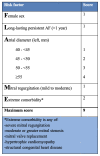Internationally validated score to predict the outcome of non-paroxysmal atrial fibrillation ablation: the 'FLAME score'
- PMID: 34348972
- PMCID: PMC8340273
- DOI: 10.1136/openhrt-2021-001653
Internationally validated score to predict the outcome of non-paroxysmal atrial fibrillation ablation: the 'FLAME score'
Abstract
Background: The clinical effectiveness of ablating non-paroxysmal atrial fibrillation (non-PAF) relies on proper patient selection. We developed and validated a scoring system to predict non-PAF ablation outcomes.
Methods: Data on 416 non-PAF ablations were analysed using binary logistic regression at a London centre. Identified preprocedural variables, which independently predicted freedom from atrial tachyarrhythmia. Twenty-one possible predictive variables and a model with c-statistic 0.751-explained outcome variation in London at mean follow-up 12±3 months. An additive point score (range 0-9) was developed-the FLAME score: female=1; long-lasting persistent atrial fibrillation=1; left atrial diameter in mm: 40 to <45 = 1, 45 to <50 = 2, 50 to <55=3, ≥55 =4; mitral regurgitation (MR) mild to moderate=1; extreme comorbidity=2. Extreme comorbidities include severe MR, moderate mitral stenosis, mitral replacement, hypertrophic cardiomyopathy or congenital heart disease.
Results: The FLAME score was applied to data (882 non-PAF ablations) at a Californian centre, and predicted the outcome of both single (p<0.0001) and multiple (p<0.0001) procedures. For first ablation (follow-up 2.1 years (median, IQR 1.0-4.1)), FLAME score: 0-1 predicts 62% success, 2-4 44% and ≥5 29% (Ptrend <0.0001). After the final ablation (mean procedures: 1.4±0.6, follow-up 1.8 years (median, IQR 0.8-3.6)), FLAME score: 0-1 predicts 81% success, 2-4 65% and ≥5 44% (Ptrend <0.0001).
Conclusions: FLAME score is easily calculated, derived in London, and predicted single and multiple procedural outcomes for non-PAF ablations in California. In patients with a high score, even multiple procedures are usually ineffective.
Keywords: atrial fibrillation; electrophysiology; health care; outcome assessment.
© Author(s) (or their employer(s)) 2021. Re-use permitted under CC BY-NC. No commercial re-use. See rights and permissions. Published by BMJ.
Conflict of interest statement
Competing interests: None declared.
Figures



References
MeSH terms
LinkOut - more resources
Full Text Sources
Medical
